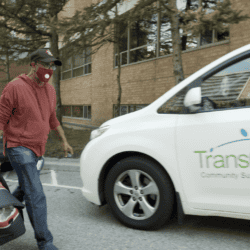Although Canada is one of the richest countries in the world, there are many high schools in its urban centres and First Nations communities where fewer than one in five students graduate from high school. Every student who doesn’t finish secondary school is a tragedy. These non-graduates suffer throughout their lives without the basic skills needed to qualify for employment, to pursue post-secondary education, and to thrive in our fast-paced, information-rich society. Sadly, inner city and First Nations schools often face the same vicious cycle: the communities that need leadership the most have fewest role models and the lowest level of personal investment in the success of youth.
I have been lucky enough to have the opportunity to work in developing communities both here in Canada and overseas. When I discovered this “diploma gap,” I set out to visit poorly performing high schools. As I talked to thousands of kids about my work, I asked them one question: “What would motivate you to stay in school?”
Their answer was simple: “Projects that are interesting and relevant to us.”
Whether they cared about the environment or technology, starting a business or creative arts, they wanted to be engaged in hands-on, real-world experiences. After I spoke with students, many of their teachers and principals approached me to say, “We don’t ask our students often enough what it is they want.”
The feedback I received from students and teachers planted the seed of an idea in my mind. I returned to Montréal and approached both Concordia University and the Social Development Society of Ville-Marie about becoming partners in an innovative program to counter high school dropout rates and increase academic success in our local high schools.
The idea was simple and yet had never been implemented in Canada: hire university students and recent graduates, and send them into poorly performing schools to implement projects that motivate teenagers to stay in school and strengthen their school spirit and sense of belonging. The university students would be present in the school and committed to working with the teenagers 15 hours per week throughout the academic year, from September to June.
This model set the stage for a mutually beneficial exchange. Children in the most disadvantaged schools got a chance to be involved in compelling activities, and undergrads and recent graduates gained real-world, career-related experience to complement their studies. Seeing that this model would create invaluable opportunities for their students and grads, Concordia University agreed to finance the salaries of the university students who would work as project coordinators. The Social Development Society of Ville-Marie agreed to provide complementary funding for a pilot project, which took place in two Montréal schools from January to June 2009.
We decided to implement our activities in the schools with the lowest academic standings in Québec. The schools each chose a number of extra-curricular projects with input from the student body. Our partnership with Concordia enabled us to hire project coordinators with an academic background in each domain who were enthusiastic and dedicated to their work with youth. Projects were varied:
• Environmental science students started green teams and promoted sustainable development.
• Journalism grads launched youth-led newspapers.
• Exercise science students kicked off sports activities.
• MBA students started businesses and entrepreneurial projects.
• Music grads taught music and organized concerts.
• Political science grads promoted civic responsibility and democratic engagement.
• Engineering students built robots and organized science fairs.
That’s how Youth Fusion was born.
The idea caught on and our efforts were very successful, leading to a decrease in absenteeism rates and an increase in graduation rates in the schools where the pilot project took place.
Mobilizing universities
Given the success of our pilot projects, all of Montréal’s universities decided to join the cause and contribute to the development of Youth Fusion. Concordia University, McGill University, Université de Montréal, Université du Québec à Montréal (UQÀM), Polytechnique, École de technologie supérieure (ÉTS), and HEC are now partners of Youth Fusion. Moreover, Laval University in Québec City, the Ministry of Education, Leisure and Sport in Québec, three school boards in Montréal, two Cree schools in the James Bay region of Québec, BMO Financial Group Québec, the J.W. McConnell Family Foundation, Vigilant Futures, TD Financial Group, the City of Montréal, the Conférence régionale des élus de Montréal, and the Forum Jeunesse de l’Île de Montréal came on board.
Furthermore, the demand for Youth Fusion’s innovative programming led to a rapid increase in the size and reach of our organization. In two years, we grew:
• from employing seven university students to employing 45 who work as project coordinators;
• from projects in two schools to projects in 16 schools, including two in the Cree Nations of Northern Québec;
• from one university partner to eight; and
• from one employee to 50.
With each new school, the diversity of projects increases, and we now develop activities in more fields and areas of interest: cinema and video, law, radio, interculturalism, communications, theatre, dance, and advanced robotics.
Some people have asked me, “Why would universities invest funds in these types of activities?” The answer is quite simple. Universities base their strategic plans on three main pillars: research, academic life, and community outreach. Youth Fusion’s program is founded upon both the academic pillar—offering creative professional experiences to university students—and the community outreach pillar—contributing to solving the dropout problem in local high schools. Universities recognized that increasing dropout rates will eventually affect their ability to recruit quality candidates if they don’t do something to promote perseverance and academic success today.
A robot to keep kids in school?
Let me share one of my favourite examples of how Youth Fusion’s program actually works.
At the beginning of April, 45 teenagers from four public high schools travelled from Mon—tréal to Toronto. For many of them, it was their first time in a new city, and they had come to take on a huge challenge: competing in an international robotics competition called FIRST. With the help of engineering students and professional mentors, each team had had six weeks to build a robot that could play soccer well enough to defeat 48 opponents.
Our four robots were relatively simple—just the fact that they moved was a huge achievement! They were, however, facing intimidating opponents with advanced technologies like multi-directional wheels and the ability to score a goal from 20 feet away.
Despite the intense competition, our kids still managed to get to the semi-finals. They even won the Judges’ Award for Perseverance.
But that’s not even my favourite part of the story.
After the competition, one of the kids in our program came up to me and said, “Thank you for this. I think I’ve decided: I want to become an engineer. And next year, we’ll be back here. But promise me one thing.” So I said, “Of course, anything.” And he said, “Get us some of those multi-directional wheels.”
Just a year ago, this kid was on the verge of dropping out of school; now, nothing was further from his mind. He had a career in mind and a future to plan for. He wasn’t thinking about leaving school. He was thinking about improving, growing, and coming back to claim the victory he knew was his.
Engaging society to counter dropout rates
Getting kids to persevere cannot be done without mobilizing society as a whole. These accomplishments and success stories have been possible because many individuals decided to work together to tackle the human tragedy of dropping out. And although it seems as though everything at Youth Fusion came together quite easily, it actually took a while to set up the program.
It took me over one year to carry out intensive research on the topic, assess needs, and meet all the students in the various high schools. Then, the main challenge was to convince one university to believe in the idea. Luckily, Concordia University has forwardthinking leaders who believed in me: Kathy Assayag, Vice-President at Concordia, took a daring chance and secured the funding to test the pilot project. The positive outcomes encouraged us to expand the program and, with the help of Evelyne Abitbol, the former Director of Government Relations and Public Affairs at Concordia, we reached out to the other six universities in Montréal and successfully mobilized them all.
Around the same time, Jacques Ménard, President of BMO Financial Group Québec, was in the midst of publishing Beyond the Numbers, a Matter of the Heart, a book about what society can do to reduce the dropout rate. Mr. Ménard and his action group on student retention and success had been looking for innovative solutions and approaches to prevent young people from giving up. When he heard about Youth Fusion’s social innovation, he contacted me and offered his support by taking on the role of chair of our board of directors. Mr. Ménard has indeed gone from words to action and has helped to expand our programs in Québec.
Similarly, Tim Brodhead, President of the J.W. McConnell Family Foundation, had heard about our work and became a great mentor. He has involved Youth Fusion in many activities organized by the Social Innovation Generation (SIG). Mr. Brodhead has seen the positive effects of our efforts and will guide us as we expand Youth Fusion across Québec and Canada.
Lessons learned from working in First Nations communities
After visiting many Cree schools in Northern Québec, I realized that First Nations communities were struggling in an education system that was not adapted to their interests and way of life. According to a 2008 Cree School Board report, students were missing an average of 43 school days per year, and fewer than one in 10 was graduating high school within the allotted five years. In 2010, we put together a pilot project in two Cree schools with the financial support of the Millennium Scholarship Foundation and Cree Human Resources Development, an organization that aims to increase employment skills within communities.
Through this experience, we learned more about the role that Youth Fusion could have in First Nations communities. Our project coordinators worked with local teachers to make school learning more relevant for teenagers. Film and animation projects, field trips, outdoor activities, and international cultural exchanges were all ways to take students’ strengths and interests into account. By the end of the semester, students were proud of what they had created and achieved. We also realized how important it is in this context to reach out to parents and the community through things like student radio shows, newsletters, open events, and partnerships with local organizations.
The project coordinators, who were university graduates in the fields of environment, communications, and human relations, had a chance to experience the Cree culture first-hand, and to learn about the challenges and opportunities facing Canada’s First Nations and northern communities, which they will carry with them throughout their lives and careers.
Lessons learned: listening to our youth
As I write this, I cannot help but think about what teachers and principals told me when I visited all those schools three years ago: “We don’t ask our students often enough what it is they want.”
That is the heart of the problem behind apathy, delinquency, and dropouts. If we really want to empower our youth, we need to listen to what they have to say and act upon it. We need to realize that their ideas and input can have a positive impact on our own work. That is why, at Youth Fusion, high school students are involved in all the steps of our decision-making processes, from choosing the activities to interviewing the project co-ordinators for the job.
By seeking input from youth and creating opportunities that personally interest them, we are helping to transform school from a seemingly irrelevant chore into an engaging community, a place where students want to spend their time and invest their energy.
With the support, dedication, and enthusiasm of our team and partners, we are getting kids thinking about what they want to be rather than wondering what they could have been. We are turning them into leaders and helping them discover their personal strengths and passions—one student at a time. In doing so, we are transforming the communities that need it the most, and enriching our great nation.
Gabriel Bran Lopez is the founding executive director of Youth Fusion. In the past few years, he has focused on education-related issues: he was at the head of The Generations Pact environmental project and led international development projects in Senegal and Uganda. Gabriel holds a degree in Communication Studies from Concordia University and has received awards from the Public Policy Forum, Forces Avenir, and the Jeanne Sauvé Foundation for his contributions to public life in Canada. Email: info@ youthfusionquébec.org .


